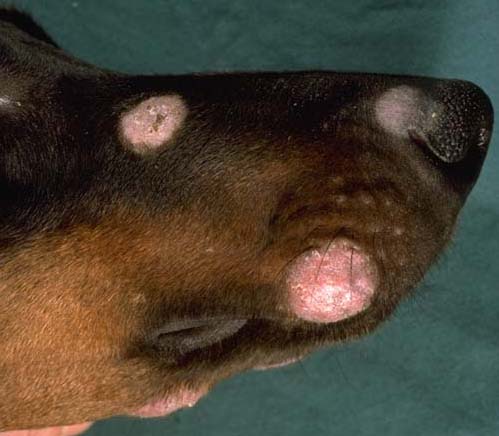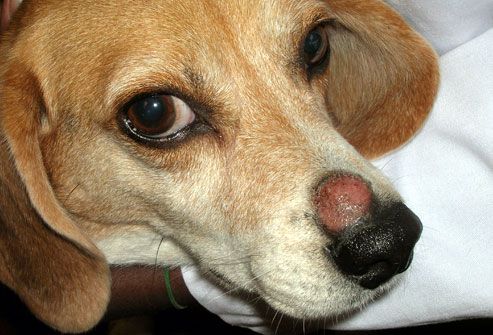Ringworm is one of those infections that you often don’t see until it has gotten a good hold into the skin of your dog and when it has, you are never quite sure whether its something you can touch or you should leave well alone.
What does ringworm look like on a dog? A Circular or Ring shaped swelling creating a balding patch as the hair begins to disappear. It’s a fungal infection of the top layers of the skin affecting the growth of the hair in the immediate vicinity of the infection. Ringworm is generally quite harmless to both dogs and humans and is easily treatable with a visit to the vet and then the application of creams or medication.

You’re probably imagining a long, gangly worm wriggling around in the infected host in the shape of a circle. Well, you’re not even close.
Ringworm is not a worm or even caused by a worm, it is a fungal infection of the skin.
In this article we will take a look at where and how your beloved companion could get infected.
We look at how to cure it and prevent further infection, plus, what are the chances are of you becoming infected.

Can Humans catch Ringworm from an Infected Dog?
Ringworm is a contagious fungi and yes, you can catch it by coming in direct contact with an infected dog.
However, you can only get infected if you have broken skin, i.e. a scratch, graze, a wound, or if you suffer from a skin condition like eczema.
Most common illnesses among pets – such as distemper, canine parvovirus and heart worms – can’t spread to humans (luckily!).
But our pets can carry certain bacteria, viruses, parasites and fungi that are transmittable to us and could make us quite sick.
Ringworm IS such a virus.
As is the case with any illness or infection, people with weaker immune systems (young children, elderly people, people undergoing chemotherapy or treatment involving transplants or transfusions) are also more at a risk of getting infected.

If you haven’t picked up ringworm from your dog by the time your vet diagnoses them with it, then congrats! you probably won’t get it at all.
In people, ringworm causes a scaly, crusted rash that may appear as round, ring-like red patches on the skin.
Other symptoms and signs of ringworm include patches of hair loss or scaling on the scalp, itching, and blister-like lesions. This explains where they got their name from!
How long does Ringworm last in a Dog?
Ringworm can last from 6 weeks to 18 months, but, it is not that serious compared to other infections or diseases. It won’t kill your dog and won’t cause any permanent damage either.
They could have been infected for a while before you start noticing the signs, which are very similar to the signs humans will show. Some of these include:
- Dandruff-like scaling in the depths of the coat
- Red lesions on the head, chest, forelegs and the ridge of the back
- Scaling, crusting, thickening and reddening of the skin
- Circular patches of hair loss on the head, tail or the ridge of the dog’s back
The sooner you take them to the vet and start with treatment the easier it will be to get rid of the ringworm completely!
Once you start treating your pup it usually takes a minimum of 6 weeks for the infection to disappear entirely. That’s assuming that they don’t get infected again.

Ringworm spores (seeds) are very resilient and can live in the right environment for a long time – possibly up to 18 months.
So the best thing you can do is to try and restrict your dog to a single space or room in your home and keep contact with your other pets or household members to a minimum whilst the treatment is on-going.
If you do not they may end up spreading the spores and possibly infecting you and also re-infecting themselves again.

If you can deep clean the area where the dog spends its time such as beds, kennels etc then you can help to stop any reinfection thus reducing the timespan it takes to get rid of this virus.
How Does a Dog get Ringworm?
Dogs get infected the same way humans do; through an open wound or broken skin.
Puppies, elderly dogs, or long-haired breeds are also more commonly affected. They will first pick up the infection through direct contact either from another infected animal or a contaminated area or object.
The incubation period between exposure to the ringworm and the development of ringworm lesions usually ranges from seven to fourteen days, in some cases it may take up to 21 days before signs of any infection develop!
And in all that time you dog has potentially been spreading the infection.
Some puppies even carry the ringworm without showing any signs of being infected.
These are called ‘asymptomatic carriers’ and are especially problematic since they will be spreading the infection to other animals and people and you won’t even know that they’re the one doing the dirty deed.

Remember, ringworm is a fungus and funguses thrive in damp, dirty or warm areas.
So if you have an outbreak keep your living space clean and keep an eye on your pet when letting them play outside or going for walks.
Ultimately, there is no way to prevent your dog completely from ever getting infected by ringworm, or similar diseases. But you can help make it less likely to happen.
How to Treat Ringworm in Dogs
Treating Ringworm can easily be done with oral medications and/or a variety of creams, sprays and shampoos.
Many options will be available at your pet shop from your local vet or even online as shown below.

Detecting ringworm is actually quite difficult, since the symptoms look so similar to any normal skin condition or affliction.
If your pup doesn’t have any skin condition history though, take them to the vet as soon as you notice the signs, to prevent any further spread of the infection.
If you have other pets, it’s very important that you check them for infection as well.
After confirming that they are indeed suffering from ringworm, the vet will give you oral medication and/or ointments and shampoos to treat it.
The oral medication will stop the ringworm from reproducing, which is the first and most important step in the process of getting rid of it.
Note, that it’s very important you don’t abruptly stop treatment, or stop it sooner than recommended. This will just lead to re-infection and the whole cycle will repeat.
Next there is the topical medication (something that is applied to the skin).
Depending on how widespread the infection already is, they may give you an anti-fungal shampoo that you will need to wash your dog with twice a week (or as instructed by your vet or the product instructions).
For milder cases they’ll give you medicated ointments or creams that you apply to the lesions directly.
If your dog has long hair, your vet may also recommend shaving the areas in question or cutting your dog’s hair short to aid in the treatment and speed up recovery.
If you’ve managed to detect the signs of infection early on enough your vet might only give you a topical treatment.
However, for best results, it’s recommended to use the oral and the topical medication in combination.
Also, be sure to let them know if you have other pets at home depending on the level of infection, your vet might advise to treat all of your pets together to ensure a swift eradication of the ringworm.
Home Treatment for Ringworm in Dogs
If you want to try treatment for your dog at home then there are a number of mixed solutions online.
Ring Out Spray is widely available online at Amazon and is recommended by the American Veterinary Medical Association

Whilst you’re treating your dog you will need to treat your living area as well.
Ringworms live on both skin and hair and are thus easily transmitted throughout the whole space by loose hair on your carpets or furniture.
A spray is ideal for this joint attack by spraying your pet and its bedding area.

Other Home Remedies for Ringworm in Dogs
If you think you need a tougher approach or simply don’t like sprays then other home remedies for ringworm in dogs is a cream or ointment. A really effective ointment is the All Natural Terrasil Ringworm Treatment and comes highly recommended, check out the online customer reviews.

A thorough deep clean is recommended:
- Vacuum or steam clean any carpets, furniture and dog beds or blankets – including underneath beds and couches. Basically everywhere your dog has been
- Wash down all surfaces with a good cleaning agent – something like bleach or any disinfectant
- If your dog has a toy or something that isn’t cleanable, get rid of it (sorry buddy, it’s for the best)
- Make sure to also clean your slippers or anything similar where any of the dog hair might have fallen.
You will also want to clean more regularly during the treatment time for maximum prevention of re-infection.
If you want to treat ringworm in dogs at home then cleaning the living area with something like apple cider vinegar or an anti-bacterial spray or wipe can be really effective.
Otherwise use a combination of the spray on the bedding and living area and the ointment on the dog or even yourself.
In Conclusion
Ringworm is hardly a life threatening infection it just looks nasty and unless your dog, or you, are immune compromised or have broken skin, your chances of getting infected are slim.
Recovery times vary and it could be up to a year before you can be sure that there is no risk of re-infection. And just like with any infectious disease, your dog and you could get re-infected again at any time.
The tricky part once infected is getting rid of them again as they spread so easily and the spores are tough tough to get rid of.
So, as they say the best cure is prevention and as long as you keep your environment clean and take care as to where you let your dog play outside, you’ll be fine.

